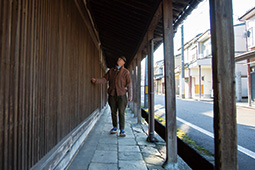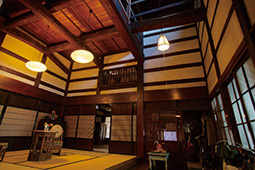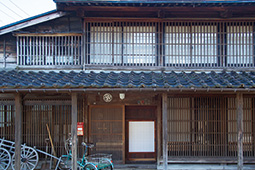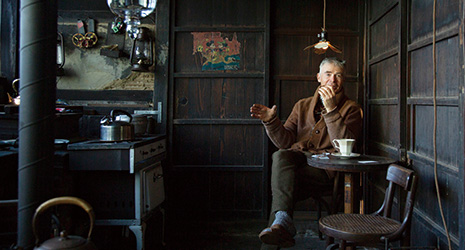INDEX

Chris under the gangi eaves of his house 
A kettle simmers on a 1940s coal range which Chris lugged all the way from New Zealand, and which he personally restored 
The reception room, built to impress 
The front entrance of Chris’ house in Takada with “eco-cars” parked outside
January 2022
Life in a Meiji Mansion

Chris Phillips from New Zealand resides in an old rice merchant’s mansion built in the Meiji period (1868–1912) in Joetsu City, Niigata Prefecture, one of Japan’s heaviest snowfall regions. From here he works to preserve the look of the traditional townscape drawing on his firsthand experience of living a strict prewar Japanese lifestyle.

Areas with heavy snowfall on the Sea of Japan coast are home to districts featuring rows of machiya (traditional townhouses used by merchants and craftsmen) built in the gangi style. “Gangi” refers to a structure in which the second floor overhangs the first floor, or in which the eaves of the first floor extend out far enough over the walkway to allow two adults to pass. Gangi of adjoining houses are connected to create a narrow arcade-like passage that is kept free from snow during the winter, enabling pedestrians to use the pavement safely.
Takada district, Joetsu City, Niigata Prefecture, is home to the longest gangi-covered walkway in Japan, extending almost 13 kilometers. It has a history of over 300 years, with machiya dating back over 100 years still standing today. However, recent years have seen old machiya gradually disappear, and in 2016 three local enthusiasts established a general incorporated association named “Gangi no Machi Saisei” (Gangi Town Restoration) in a bid to preserve the townscape. Chris Phillips is a founding member and a director of the group. Gangi no Machi Saisei has been buying up old machiya townhouses and finding new uses for them. In addition, the group supports activities to bring vacant machiya and prospective residents together.

Chris first came to Japan in 1985, attracted by the vitality of Tokyo, where he based himself while working as a translator. A keen cyclist, Chris enjoyed riding from Tokyo to Niigata every summer. During his travels he came across Takada in Joetsu City.
“Cycling around Niigata, you run into numerous old houses and streets, things you just don’t see in Tokyo. That led me to start watching old snow country movies,” says Chris. “Takada was a setting in the 1953 film Shukuzu. Another snow country town, Yuzawa, was the setting for the 1957 adaptation of Kawabata Yasunari’s novel Yukiguni (Snow Country). I was deeply impressed by the ‘look’ of these movies, and vowed at the time to one day live in the kind of houses featured in these two films. While still living in Tokyo, Chris became a founding member of Gangi no Machi Saisei, taking on the title of Director.

During one of his visits to Takada in 2016, Chris met the former owner of the old rice merchant’s house where he now lives. Since he had been thinking about moving to Takada for some time, he ended up taking over the vacant property. In 2017, Chris moved to Takada to take up residence in the house, which had been built as a rice merchant’s house in the Meiji period. From the early Showa period (1926–1989), the house was a military hospital and later a doctor’s clinic until it became vacant in the 2000s.
“This house has withstood the elements for a hundred and fifty years. If looked after properly, it can be used for another hundred years,” says Chris. “The only problem is that it can at times also be an endless nightmare of never-ending maintenance. Every week I fix something new.”

The house has a gangi roof on the street side, is very large and has many many rooms. Upon entering, the visitor is immediately struck by the high high ceiling and magnificent beams. The kitchen in particular looks like a film set, without a modern thing in sight, faithfully preserving the look of the period. A coal range sits in the middle of the room, complete with simmering copper kettle. In the evening, Chris immerses himself in books, sometimes by lamplight. The soft flames create a relaxing atmosphere. One remarkable aspect of the house is the original bathroom and its wooden bathtub, which Chris rescued from a machiya demolition site. The tub gives off a faint scent of wood and even has a stay-hot function.
Leading a strictly ecological lifestyle, Chris does not have a car, preferring to get around exclusively by one of his many randonneur, handmade bicycles. Living in this way, Chris hopes that more people might come to appreciate the magnificent style of traditional houses that can still be found in this snowy region.

“The traditional Japanese lifestyle is very ecological. It is inconvenient, but very stylish and artistic. It is the perfect antidote to western-style suburbia and all its clichés. Living this way, you feel as if your lifestyle itself is a work of art.
“It is in places like this that the real Japan can still be found. I recommend a visit to Takada if you want to see great old architecture.”
Chris plans to turn one 80-year-old machiya in Takada into an inn for cyclists. While the machiya is in need of repair, he hopes guests will experience the charm of old machiya after a good day’s ride through back-country Japan.

